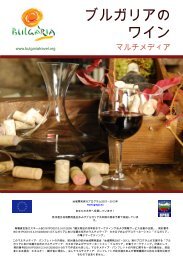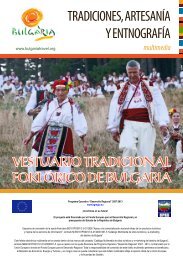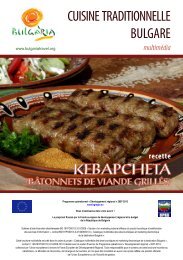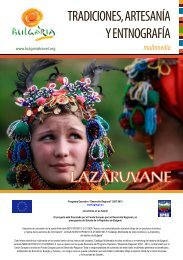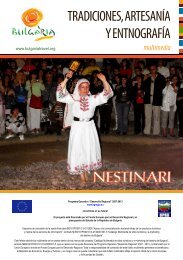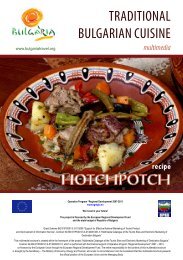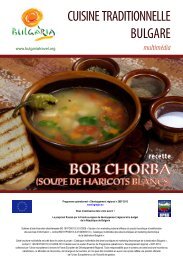Create successful ePaper yourself
Turn your PDF publications into a flip-book with our unique Google optimized e-Paper software.
Discoverthe wild charmof the <strong>Bulgaria</strong>n <strong>Danube</strong>
Depicted by great composers and poets, the blue <strong>Danube</strong> isclosely linked to <strong>Bulgaria</strong>n history since the establishment ofthe first <strong>Bulgaria</strong>n state in the Balkans. Today the great riverforms a 480km long northern border with Romania.Our grandparents remember when it used to be completelyfrozen over and how wedding guests with caravans and cartscrossed the ice from one bank to the other. Wild animalsdid the same in their search for food during the cold wintermonths and found new hunting grounds on the opposite side.In this part of Europe, the <strong>Danube</strong> has retained its wild charm.Forests and wetlands dominate its entire length. Desertedislands enlivened only by birds, riverside marshes and lakesfull of biodiversity, fishing villages, several towns of around30,000 inhabitants and only one city of 145,000 – welcometo the <strong>Bulgaria</strong>n <strong>Danube</strong>.The <strong>Bulgaria</strong>n bank of the <strong>Danube</strong> holds unexpected treasuresand beauties. Perhaps because this region has always beenfar removed from major investment projects or any kind oftourism, its authenticity has been preserved. Here you find theremains of Roman towns, which once guarded the northernfrontier of the empire; ancient <strong>Bulgaria</strong>n castles; Turkishmilitary forts; the best preserved painted rock churches frommedieval times; impressive Thracian tombs and MuslimTekkes (mosque complexes). A number of these monumentsare listed as UNESCO World Heritage Sites.Traditions live on through numerous folklore groups, localfestivals and colourful costumes. This northern folkloreis particularly popular in <strong>Bulgaria</strong> with its combination ofViennese waltzes and the Balkan rhythms of the region. Ofparticular note is the culture of wine and local cuisine. Gamzafrom Novo Selo; sparkling wine from Magura; SvishtovskaCherga; Vratshanska Temenuga (Muscat), the wineries inOryahovo, Lyaskovets, Ruse, Silistra, Pleven, are witnessto long traditions. Like along on all major rivers, fish is aspeciality. But in general the cuisine is dominated by <strong>Bulgaria</strong>nnational characteristics – banitsa, shopska salad, stuffed vineleaves, yoghurt and delicious vegetables and fruits.Even for many <strong>Bulgaria</strong>ns, the Lower <strong>Danube</strong> is somethingof a mystery. <strong>Travel</strong>ling downstream by boat towardsthe sunrise, you see only green forests, wild islands andoccasional lights indicating a human presence. Havingpreserved its longstanding beauty, the river is today a bridgebetween Balkan countries, creating an active Europeanpartnership and bilateral cooperation.Borders between countries are not what they used to be.It is definitely time to discover the <strong>Bulgaria</strong>n <strong>Danube</strong>!
BelogradchikChiprovtsiVidin is situated on the right bank of the <strong>Danube</strong>, in thenorthwest corner of <strong>Bulgaria</strong>, about 5 km across the riverfrom the Romanian town of Kalafat and 20 km from theSerbian border. It is a favourite stop for all cruises goingon the <strong>Danube</strong>. Vidin was settled in the third century B.C.by the Thracian tribe, Tribali. Later on it became part of theRoman province of Upper Mizia. In the Middle Ages, it wasthe capital city of one of the <strong>Bulgaria</strong>n Kingdoms for almost50 years before it fell under Ottoman rule in 1396. Stillstanding today is the Baba Vida Fortress, <strong>Bulgaria</strong>’s bestpreservedmedieval citadel.Belogradchik is a small town, situated in an extremelypicturesque region with unique rock formations and a wellpreserved Ottoman fortress. Nature has carved out of thered stone huge pillars and figures which look like soldiers,monks, wild creatures and fairy tale heroes. It is the mostamazing geological site in this part of the Balkans. Andit offers excellent opportunities for hiking, caving, biking,rockclimbing, fishing or even astronomy.Here, at the end of the world… you find the little town ofChiprovtsi, hidden in the Western Balkan Mountains. It isfamous for its centuries old carpet-weaving tradition whichstill thrives today, thanks to the technical school and localcraftsmen. Second-hand carpets from Chiprovtsi are one ofthe latest trends in home decoration, especially in France.Vratsa, situated at the foot of Vratchansky BalkanMountain, has retained its atmosphere and charm fromthe beginning of the 20th century. The history museum isfamous for its extremely valuable golden Thracian treasuriesand original examples from the famous Vratsa goldsmiths’school. Vrachanski Balkan Nature Park is situatednearby. It represents one of the richest regions of karstrock formations in <strong>Bulgaria</strong>, featuring caves, precipices,waterfalls, huge limestone formations ideal for rockclimbing.It is a favourite place for climbers all year roundand a starting point for hiking and mountain-biking routes.The park also offers opportunities for village tourism in smallfamily-run guesthouses.Iskar Gorge is a natural miracle of the Stara Planinamountain range. For thousands of years the waters of theIskar River have dug their way into the rock and carved outincredible shapes. The total length of the gorge is 156 km. Itoffers wonderful hiking and biking trails, old monasteries tovisit, caves, waterfalls and lots of small villages.Cherepish monasteryCherepish Monastery of the Assumption dates backto 1370. During the Ottoman occupation it became animportant educational centre. The famous CherepishGospel was bound here in 1512 with gold covers anddecorated with biblical scenes.Vratsa5
PlevenSilistra
Pleven is located in the central part of the <strong>Danube</strong> plain. Thecity was a major battle ground during the Russian-TurkishWar of 1877–1878. The joint Russian and Romanian armypaid dearly for the victory, but it paved the way for the defeatof the Ottoman Empire, the restoration of <strong>Bulgaria</strong> as a stateand the independence of Romania. Therefore almost all thelandmarks in Pleven are related to this War of Liberation.In the centre of town is a Mausoleum dedicated to theRussian and Romanian soldiers who died during the war. Therenowned Pleven Epic 1877 Panorama was created in honourof the 100th anniversary of the battle and was modelled onthe Borodin Panorama in Moscow. And the Museum of Wineis the best of its kind in <strong>Bulgaria</strong>.Svishtov is situated on a high terrace where the <strong>Danube</strong>reaches its most southern point in <strong>Bulgaria</strong>. The town firstcame to prominence in 483 AD, when Theodoric the Greatestablished his capital Nove here. In Svishtov there are manyarchaeological, artistic and architectural monuments ofnational importance.Toutrakan is on the high <strong>Bulgaria</strong>n bank of the <strong>Danube</strong>, 433km from the Delta. Many of its old buildings are influencedby Romanian architecture. The <strong>Danube</strong> Museum of Fishing& Boatbuilding is housed in the town’s former public baths.Among 500 artefacts, depicting the history of fishing, onecan see nets, harpoons, fishing boats… all typical of life inToutrakan.Silistra is situated on the right bank of the <strong>Danube</strong>, 375 kmfrom the Delta. Landmarks in Silistra are the Town Museumof History and the Ethnographic Museum. Remnants of theancient Roman fortress and a Turkish military fortification areto be seen at diff erent places in the town and along the riverbank. Half of all <strong>Bulgaria</strong>’s apricots grow here in the Silistraregion, which makes it the most popular place to tasteapricot brandy.ToutrakanSvishtovSveshtariThe Sveshtari Thracian Tomb (3rd century BC) reflectsthe fundamental principles of the structure of Thraciancult buildings. The tomb has a unique architectural decor.The discovery of the Thracian Tomb of Sveshtari was oneof the most spectacular archaeological events of the late20th century. Sveshtari is a UNESCO World Heritage Site.Demir Baba Tekke is a 16th-century Alevi mausoleumnear the village of Sveshtari in the Isperih municipality.The mausoleum is thought to be the resting placeof Demir Baba, a 16th-century Alevi saint. The tombitself is a heptagonal building constructed out of localsandstone. There is a holy spring nearby. The Tekke islocated in a region, populated mainly by Muslims, whichgives opportunities to visit beautiful mosques in thetowns of Razgrad, Targovishte and Shumen.7
The development of cultural, cruise, festivaland conference tourism within the regionis based on a rich cultural program whichincludes events such as the March MusicDays (international festival for symphonic& cantata-oratorio), the Golden Rebeck FolkFestival, The Jazz Fest–Ruse and the TheatreDays Festival.Ruse is the largest <strong>Bulgaria</strong>n city on the <strong>Danube</strong> and is thebirthplace of Elias Canetti, the 1981 Nobel Prize Winnerfor Literature. It is described as the ‘Pearl of the <strong>Danube</strong>’and is considered to be amongst the most beautiful citiesin <strong>Bulgaria</strong>. It is a crossroads on the international routebetween Bucharest and Istanbul, over the only bridgebetween <strong>Bulgaria</strong> and Romania, and is one of the mostimportant water corridors on the Lower <strong>Danube</strong>. Thedistance to the Romanian capital Bucharest is just 72 km.Ruse occupies a significant role in the <strong>Bulgaria</strong>n nationalhistory. The city was founded in the 1st century as aRoman military fortifi cation with a river port, and wasnamed Sexaginta Prista – the port of 60 vessels. UnderOttoman rule, Ruse was the administrative centre of alarge region. After the Russian–Turkish war of liberationin 1877-1878, it became the biggest city in independent<strong>Bulgaria</strong>. As a result of the wide range of economic andcultural contacts with the countries along the <strong>Danube</strong>,Ruse grew into a modern city, with a predominantlyEuropean appearance and traditions.Numerous elegant buildings were designed by Italian,Austrian, German and <strong>Bulgaria</strong>n architects.9
Tsarevets Hill Archaeological ReserveThe site is in the eastern part of the town. Its restored fortified walls in combination with perfect natural defences providedsafety to the key institutions of the <strong>Bulgaria</strong>n medieval state. The so-called Baldwin Tower rises in the most southern part of thefortress. Here the Latin Emperor Baldwin was captured by Tsar Kaloyan after the defeat of the Crusaders in 1205 near Odrin.For the past two years Tsarevets has also been a unique setting for open-air concerts.
Veliko Tarnovo is one of the most enchanting and charmingcities in <strong>Bulgaria</strong>. It stretches along both banks of the riverYantra which cuts a spectacular gorge through the Pre-Balkan Mountains. Famous for its historic role as capital ofthe Second <strong>Bulgaria</strong>n Kingdom (1187 – 1393), it is now anattractive modern city, a renowned university town and capitalof <strong>Bulgaria</strong>n arts & crafts. The city’s ‘Sound & Light show’is outstanding and uses the historic city walls as a naturalbackdrop.Gurko Street has carried through the ages the atmosphereof the <strong>Bulgaria</strong>n National Revival. The 18th & 19th centuryhouses rise above one another on the rocky banks of Yantra andare reflected in its waters. Cosy cafes, small restaurants, artgalleries and ethnographic exhibitions blend with the past in avery romantic way.Arbanassi is located 4 km away on a hill above the lightsof Veliko Tarnovo. It flourished as a trade and crafts centrebetween the 16th & 18th centuries, when its monumental stonehouses and churches with rich interior decoration, woodcarvingsand mural paintings were built. This Arbanassi type of house canbest be described as a fortified dwelling. The village is classifiedas an Architectural & Historic Reserve of national importance.In the vicinity of Veliko Tarnovo there are dozens of famousmonasteries, Including those of the Transfiguration, the HolyTrinity, Kilifarevo, Kapinovo, Dryanovo, Liaskovets and the VirginMary in Arbanassi. Their priceless frescoes and relics prove theimportant position of Veliko Tarnovo as a Christian spiritualcentre throughout the ages, right up to the present day. Someof these monasteries offer accommodation facilities.LovechArbanassiLovech, the <strong>Bulgaria</strong>n town of lilac, is picturesquelysituated on the Osum River. It has a well-preservedmedieval fortress, dating back to 12th century. Closeto the fortifications is the old quarter of Varosha, theneighbourhood from the time of the National Revivalwith over 160 houses of characteristic architectureand the famous covered bridge of Lovech, which linksVarosha to the rest of the town.11
Traditionsand MusicThe <strong>Danube</strong> is not only the biggest river inthe Balkans, but also a bridge that bringstogether different ethnographic groups. Itinfluences the everyday life of the peopleliving along the riverside and breathes lifeinto their customs, rituals and festivals,which are associated with respect forwater as a life source and the notion ofwhat is ‘mystical’ and ‘unattainable’.Crafts and work along the <strong>Danube</strong>are naturally linked to fishing relatedoccupations such as the making ofnets, rods and other devices; thebuilding of boats and farming. Theregion of Dobrudzha in the northeasternpart of the country is thegranary of <strong>Bulgaria</strong>.Customs of the <strong>Danube</strong> settlementsplay a specific part in the overall culturalpicture of <strong>Bulgaria</strong>n society. From theceremony of St. Jordan’s Day, whenyoung men compete to find a cross in the<strong>Danube</strong> thrown in by the local priest; thewinter ‘kukeri’ mummers’ masks to therain-bringing customs, called ‘Butterfly’and ‘German’… they all depict anincredible wealth of traditions for specialdays and holidays. An iconic <strong>Bulgaria</strong>ncustom is the celebration of St. TrifonZarezan’s Day, the day on which the vinesare pruned for the first time in winter.The music of the <strong>Bulgaria</strong>n <strong>Danube</strong> isdefinitely inspired by the beauty of thearea, the peaceful and solemn flow of thegreat river, and the huge feeling of spacestretching all the way to the horizon.Famous for its two folk regions of Northern<strong>Bulgaria</strong> and Dobrudzha, the <strong>Bulgaria</strong>n<strong>Danube</strong> is the birthplace of the ingeniouscomposer of brass music, Diko Iliev,whose work skilfully combines authentic<strong>Bulgaria</strong>n and Western European musicfrom the early 20th century. PanchoVladigerov is arguably the most influential<strong>Bulgaria</strong>n composer of all time. He wasone of the first to successfully combineidioms of <strong>Bulgaria</strong>n folk music and theWest European art music tradition.Vladigerov marked the beginning of anumber of genres in <strong>Bulgaria</strong>n music,including the violin sonata and the pianotrio. He was born in Zurich, but lived andworked in Shumen and Sofia.The preservation of this unique formof <strong>Bulgaria</strong>n culture is one of the greatchallenges of modern times. Typical of<strong>Bulgaria</strong>n folk music, for example, are theirregular rhythms, high pitch, two- andthree-part singing. Modern artists haveto go back to <strong>Bulgaria</strong>’s cultural rootsto study and re-create diff erent themesfrom over one thousand years of vibrantfolklore.13
Wineand CuisineCulinary traditions and wine culture are an integral part ofthe identity of <strong>Bulgaria</strong>. Wine production here has a longerhistory than the <strong>Bulgaria</strong>n state itself. It is a historicalfact that in the lands of the Thracians, who inhabited theterritory of modern <strong>Bulgaria</strong>, wine was part of everydaylife and pagan rituals. Archaeological findings only serveto confi rm the information we have from Homer andHerodotus. More importantly, despite the vicissitudes ofhistory, some Thracian grape varieties have survived tothe present day. Original wines from the <strong>Danube</strong> plain are:Pamid, Gamza and Miscet (Temenuga). Pelin (wormwood)is perhaps closest to the ancient tradition and often usesmore than 30 different herbs in its ageing process!Since 2000 the <strong>Bulgaria</strong>n wine industry has been achievinggreat results. In 2010 alone 19 <strong>Bulgaria</strong>n wines receivedan International Wine Challenge Award and another 26won Decanter Awards.The emergence of <strong>Bulgaria</strong>n wine tourism is already areality, and the first hotels and guesthouses have alreadybeen built next to major wineries where <strong>Bulgaria</strong> producessome of its best wines, and the next step is to createthemed wine tours. The world’s newest Wine Museumopened in Pleven in 2008. It houses a collection of morethan 7,000 bottles of <strong>Bulgaria</strong>n wines, some of them agedup to 90 years.The excellent conditions for agriculture, together with thevariety of peoples and cultures that have passed through<strong>Bulgaria</strong> have played a significant role in the wine cultureand today’s national cuisine, which is rich in regional flavours. <strong>Bulgaria</strong>ns share with neighbouring Greeks, Turks,Serbs and Romanians a true cultural treasure of commondishes. Although in terms of product denomination andcertifi cation of origin <strong>Bulgaria</strong> is still behind, there are manyexamples of local specialties that bear all the characteristicsof a single brand. In many cases the amazing varietyof herbs determines the taste and aroma of the dishes(<strong>Bulgaria</strong> ranks third in the world in the export of herbs).There is no more famous culinary product associated with<strong>Bulgaria</strong> than <strong>Bulgaria</strong>n yogurt. It is known worldwide, and<strong>Bulgaria</strong> is the true habitat of the ‘Lactic bacteria’ which isan indispensable source of health! Since 2001 they celebrateNational Yogurt Day in Razgrad. Another <strong>Bulgaria</strong>n championis Shopska salad, closely followed by the <strong>Bulgaria</strong>n ruralorganic tomatoes and Banitsa cheese pie in all its regionalvariations. A unique cooking contest is held every year at thevillage of Banitsa, between Vratsa and the <strong>Danube</strong>.35% of all <strong>Bulgaria</strong>n wines areproduced on the <strong>Danube</strong> plain.The most renown vineyards areMagura and Lyaskovo (sparklingwines), Vidinska Gamza, Lopushna,Oryahovo, Leventa (Ruse), Pleven,Svishtov, Suhindol, Targovishte…15
The Srebarna Lake Biosphere Reserve is 16 km to the west of Silistra. It comprises Lake Srebarna and the surroundingbanks of the <strong>Danube</strong>, occupying a territory of 600 hectares. It is a wonderful sight with its surface of cane and bulrushes,water lilies, marsh marigold, marsh fern, duckweed, etc. Various kinds of birds nest here – some 150 protected speciesof marsh birds such as pelicans, black coots, water swallows, egrets, ibis, wild geese, 11 species of wild ducks, etc. Thereserve is included in the UNESCO list of the most valuable natural sites worldwide.Persina Nature Park is the only one in <strong>Bulgaria</strong> to belocated along the <strong>Danube</strong> River in the Svishtov-Belenelowlands. It consists of numerous islands, marshlandsand river-line wetlands. The park is unique and the largestwetland ‘Ramsar Convention’ site for waterfowl in<strong>Bulgaria</strong>. There are two island groups – one around Nikopolconsisting of four islands and the other around the town ofBelene with19 islands.The Malak Preslavets Marshland is a protected area betweenthe towns of Tutrakan and Silistra and is a feeding ground forherons, ibis, fallow deer stags, cormorants and other birds. It isthe paradise for the white water lily (Nymphaea alba) and hereis where the largest number can be found in <strong>Bulgaria</strong>.Over 743 higher plant species inhabit the park territory. Theinternal marshes contain typical marsh communities – yellowwater lily, broad-leaved pondweed, yellow fl oating-heart andwater chestnut in the shallow parts. In the park there are also1,100 animal species. The highlight of the park is the birdlife.Over 200 species have been recorded and almost all of themhave conservation status. The Belene Island Complex is one ofthe most important regions in the world for rare species likethe whitetailed eagle, the cormorant and the heron.17Persina Nature Park
RusenskiLomIn the eastern part of the <strong>Danube</strong> plain, some 20 km south ofRuse, travellers find an island of wild nature – theNature Park Rusenski Lom. Its name derives from the riverRusenski Lom – the last tributary of the <strong>Danube</strong> on the<strong>Bulgaria</strong>n side.It is one of the few sanctuaries for the preservation of naturein north-eastern <strong>Bulgaria</strong>. The vegetation here is of bothforest and steppe varieties. The pride of the park is the rareand protected fl oral species, one of which is an indigenous<strong>Bulgaria</strong>n variety. Five others are endemic species to theBalkans. Among these are the Chamaecytisus kovacevii andVerbascum dieckianum which are found solely along riverbanks.The park is truly a paradise for bird-watchers. Many endangeredEuropean species can be seen here. Because of this, the riverbasin has been declared an Ornithological Important Place.Numerous crevices, ledges, cave entrances and platformsprovide the ideal conditions for rock-nesting birds like the blackstork (only nesting here in rocks), golden eagle, Egyptian vulture,long-legged buzzard, ruddy shelduck, saker falcon, rock dove,eagle owl and others. The park is a natural breeding area fordeer and wild boar. Wolves, foxes and other predators alsoinhabit the park. This magnifi cent network of valleys was alsoused in medieval times by monks who constructed dwellingsand churches right in the rock faces. Forty of the 250 individualdwellings which remain are located within the park.The Archaeological Reserve of the ‘Rock Churches’ near thevillage of Ivanovo includes the rock monastery of ‘St. Michaelthe Archangel’. It was one of the largest ecclesiastical andliterary centres in <strong>Bulgaria</strong> during the 13th and 14th centuries.Well preserved frescoes in six churches and chapels are amongthe most precious achievements of <strong>Bulgaria</strong>n medieval art. Thechurch of the Virgin Mary is a UNESCO World Heritage Site. Itis situated at a height of 38m and has 2 rooms and a chapel.The total area is 64m2. And the walls and ceiling are entirelycovered with frescoes!The Archaeological Reserve in the medieval town of Cherven includes theruins of a castle, a church (the former seat of regional ecclesiastical power) anda boyar palace (its secular equivalent). It is home to <strong>Bulgaria</strong>’s best preservedmedieval fortress tower in the shape of a square, 12m high with sides 8.5mlong. An impressive fortified underground water-source can also been seen here.19Town of Cherven
Among all sports along the <strong>Danube</strong> bank of <strong>Bulgaria</strong>, kayaking is probably the mostdeveloped. Lots of clubs and agencies offer tours on water mainly in calmstreams. The international cycling trail EuroVelo6 is only partly marked, so if onedecides to invest time to do it in <strong>Bulgaria</strong>, you should be aware that it will bean adventurous holiday – maybe the best way to see the true face of <strong>Bulgaria</strong>!Hiking, horse-back riding, paragliding, rock-climbing and cave-exploring are amongthe other sports one can undertake in this wild region.
Outdooractivities
Usefulcontactswww.adodunav.orgAssociation of 34 municipalities in the <strong>Danube</strong> region of<strong>Bulgaria</strong>www.bsc.rousse.bgRuse Business Support Centre, supporting SMEs in Ruse andthe region.www.danubecc.orgThe <strong>Danube</strong> Competence Centre (DCC) is an internationaltourism cooperation platform that works to build and supportnetworks of tourism stakeholders by investing in people andskills, enhancing regional cooperation and promoting themutual interests of its members. DCC aims to create asingle tourism brand for the Middle and Lower <strong>Danube</strong> region.Countries represented: Croatia, Serbia, Romania, <strong>Bulgaria</strong>,Moldova, Ukraine and Austria, with the financial support of theGovernment of Germany (GIZ). DCC is based in Belgrade.www.baatbg.org<strong>Bulgaria</strong>n Association for Alternative Tourism is a nonprofitpublic benefit organization established in 1998. Mainachievements: green certification, network of the responsibleand sustainable tourism businesses & stakeholders, innovativestrategic thinking. Among the significant projects of theassociation is the development and implementation of‘Green Lodge’ certification.www.wwf.bgWWF (originally World Wildlife Fund) has been active in<strong>Bulgaria</strong> since the early 1990s in the field of the sustainableforestry management, protected areas, freshwater as wellas agriculture and rural development. WWF runs the <strong>Danube</strong>-Carpathian Programme in <strong>Bulgaria</strong> since 1998, putting effortsto preserve, restore and sustainably manage the natural valuesof the <strong>Danube</strong>-Carpathian ecoregions.www.bepf-bg.orgThe <strong>Bulgaria</strong>n Environmental Partnership Foundation supportslocal tourism projects and the development of cycling trails, thecollection and provision of information about the traditions,cuisine and cultural & natural heritage of the <strong>Danube</strong>.www.bspb.orgThe <strong>Bulgaria</strong>n Society for the Protection of Birds (BSPB)is <strong>Bulgaria</strong>’s first (1990) and largest Non-GovernmentalOrganization dedicated to biodiversity conservation.www.bbf.biodiversity.bgThe <strong>Bulgaria</strong>n biodiversity Foundation strives to enhance thenetwork of protected natural areas in <strong>Bulgaria</strong>.www.hiking-bulgaria.comThe most comprehensive website covering outdoor activitiesand adventure in <strong>Bulgaria</strong> (Odysseia-in <strong>Travel</strong> Ltd). It presentsthe best of <strong>Bulgaria</strong> as a travel destination with real values –people, nature and all the adventures one can undertake in thewild. Tours along the <strong>Danube</strong> are featured too.Useful Links:www.visitvidin.com – information on Vidinwww.visitsvishtov.com – information on Svishtovwww.tic.rousse.bg – information on Rusewww.info.portal-silistra.net – information on Silistrawww.velikoturnovo.info – information on Velilko Tarnovowww.lomea.org – Nature Park ‘Russenski Lom’www.persina.bg – Nature Park ‘Persina’www.vr-balkan.net – Nature Park ‘Vrachanski Balkan’www.winemuseum-bg.com – Museum of Wine in Pleventicbelogradchik@gmail.com – for information on BelogradchikPhotographs in this brochure by:Alexander Ivanov, Mihail Mihov, Lubomir Popiordanov, SvidnaMihailova, Nikolai Kovachev, Rositsa Lozanova, GeorgiPalahutev, Boiko Kalev, Alexander Tonev, Laurence Fleury,Mehmed Aziz, Archives of Odysseia-in, Vrachanski BalkanNature Park and the Ministry of Economy, Energy and Tourism.All texts are written by: Mihail Mihov and LubomirPopiordanov, Odysseia-inEditing by: Bruce TaylorDesign and prepress: Zoom Design Ltd.
W W W . B U L G A R I A T R A V E L . O R GNATIONAL TOURISTINFORMATION CENTREOF THE MINISTRY OF ECONOMY,ENERGY & TOURISM1 Sveta Nedelya Square1040 Sofia, <strong>Bulgaria</strong>Tel.: +359 2 9335826,+359 2 9335811e-docs@mee.government.bgwww.bulgariatravel.org



